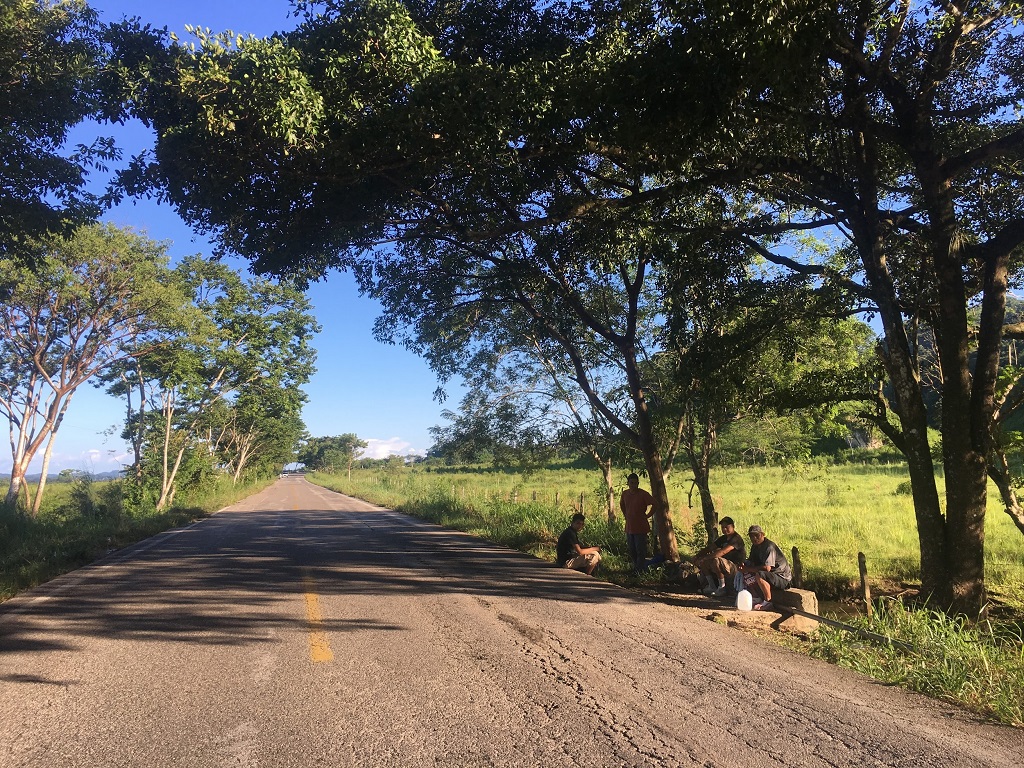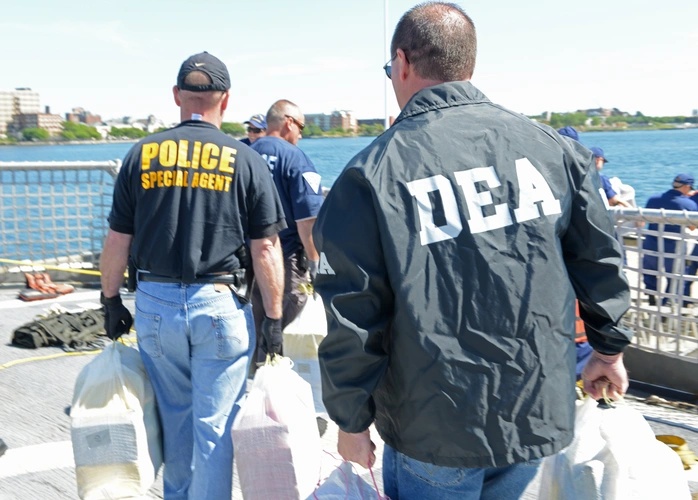The Invisible Caravans
The sun was setting over the southern Mexican highway that hugs the Guatemala-Mexico border. Any tourists sitting along the road might have taken a photo or commented to one another on the picturesque rural backdrop. Yet it barely registered for the four Hondurans with whom I was traveling. “You pass through so many beautiful places as you move through Mexico,” José said to me as he waved toward the sunset, “but you are usually too tired or miserable to enjoy it.”

Published by The Lawfare Institute
in Cooperation With

The sun was setting over the southern Mexican highway that hugs the Guatemala-Mexico border. Any tourists sitting along the road might have taken a photo or commented to one another on the picturesque rural backdrop. Yet it barely registered for the four Hondurans with whom I was traveling. “You pass through so many beautiful places as you move through Mexico,” José said to me as he waved toward the sunset, “but you are usually too tired or miserable to enjoy it.”
This was the group’s third sunset since they had set off on foot from the Mexican border town of Frontera Corozal to reach the bigger city of Palenque, Chiapas. Along this 100-mile stretch of borderlands, more than 100 migrants leave every day in continuous mini-caravans. They generally complete the walk in five to seven days, except for elderly migrants, pregnant women or those traveling with small children, who cannot keep up the brisk pace of 13 to 20 miles a day. These mini-caravans make the trek with no media attention, no assistance from international organizations, and support only from two tiny local church-run efforts that offer a roof and a hot meal if the communities donated sufficient food.
For the past week, a 5,000-person migrant caravan moving slowly up the Pacific Coast of Chiapas has attracted global attention. Videos and photos of the group storming the Guatemala-Mexico border bridge, walking the highways and resting for the next legs of their journey have impressed upon viewers the group’s size. Yet, while several thousand migrants may be a large crowd, the people traveling in the caravan make up only a fraction of the migrants trekking north in the invisible mini-caravans that move forward every day. For perspective, last month, more than 50,000 people asked for asylum at a U.S. port of entry or were apprehended along the U.S.-Mexico border. This means that while the White House plans to send thousands of U.S. troops to the border, the caravan constitutes only about 10 percent of this monthly total.
To meet some of these migrants who move invisibly, I joined José and his group of Honduran companions as they trekked onward toward Palenque. Their day had begun at 3:30 a.m. They had set out with the goal of moving quickly before the fierce midday heat arrived. The Hondurans wore baseball hats and draped shirts over their heads to shield themselves from the sun, drinking water from the plastic jugs they carried. Despite spots of shade along the highway, the unrelenting heat and the hot asphalt underfoot at times made walking unbearable. Whenever it got to be too much, the group would sprawl out in the shade, watching the passing cars and buses and lamenting how many more miles they still had to go.
José, along with the other Hondurans in his group, is from the city of Comayagua in the department of Comayagua. Before leaving for Mexico, he had worked in construction. His problem was not so much the work itself but his salary: 150 lempiras a day. “You can’t make that type of money work,” he explained before listing off basic goods and their prices: one pound of beans (13 lempiras), one pound of rice (11 lempiras), a carton of 24 eggs (67 lempiras), a bag of sugar (11 lempiras), 15 pounds of corn (85 lempiras), coffee (25 lempiras), soap to wash clothes (20 lempiras for a bar), a tube of toothpaste (20 lempiras).
When there weren’t many construction projects, he worked only three days a week, making food scarce after meeting other expenses and rent. According to Honduras’s national statistics institute, roughly 60 percent of the population cannot afford basic food supplies. This means more than just families scraping by on a range of salaries—it also means hunger. Not a single person in the group hiking to Palenque had regularly eaten three meals a day in months.
According to José and his traveling group, their economic desperation began in earnest after the 2009 coup in Honduras and had gotten worse after the reinauguration of President Juan Orlando Hernández this past January amid significant electoral irregularities. For this group, it felt like there was no way for someone born into the lower income tier to escape societal violence or to move up economically. “It’s like they say about the ocean: The bigger fishes eat the smaller ones. It feels like that in Honduras,” said José.
These are the same factors that drive tens of thousands of Honduran migrants to join caravans and head to the United States every year. The largest numbers of migrants in absolute terms come from Honduras’s biggest cities, San Pedro Sula and Tegucigalpa, driven out by gang violence, precarious employment and low salaries. However, increasing numbers of Honduran migrants come from smaller towns and rural areas, where a collapsing coffee market and low global commodity prices are worsening economic situations that were already tough. As Álex, a 20-year-old Honduran migrant from the department of Santa Barbara, explained, “In the Western part of Honduras, coffee is the only source of income. There isn't anything else, no factories or companies. Now with the low prices and the coffee rust [a disease affecting coffee plants], it’s just not profitable and the sector is going under.” Some of these rural migrants who are left without work head to major cities only to hit the same challenges as urban-dwellers. The mixture of desperation, hunger and insecurity, combined with the absence of hope for change at the ballot box, has proved a potent force for pushing Hondurans out of their homes.
As the group passed time trying to remember the prices for every basic good they would buy in Honduras, one man in the back disappeared without anyone noticing. “He’s gone,” someone said, as others in the group looked back without breaking pace. The man had joined the group in the morning and walked silently the whole day, hobbling along in broken shoes without laces. No one knew his name or where he was from. These temporary relationships are common on the highway; our group grew and shrank throughout the day as people joined and others ducked out to rest. As the group scanned the horizon for the lost member, the travelers reached a quick consensus before moving on: “He probably couldn’t take the pain anymore.”
The pain they referred to comes from blisters, the enemy of all walking migrants. Cheap shoes, sweat-soaked socks and walking tens of miles a day all grind at migrant feet. The resulting blisters leave migrants limping and hobbling across the 100-mile stretch. To make walking bearable, some people get creative. They use whatever they can find for protection and commonly insert feminine pads as extra cushion in the bottoms of their shoes. Others limp along quietly, gritting their teeth against the pain. José and his group took off their shoes during every break, letting their feet dry out and switching to dry socks.
Blisters do not discriminate by age. A six-year-old boy and his parents joined José’s group for an hour, and the boy’s small feet were covered in blisters. Yet he continued to run up and down the highway, chasing his father, who had pulled ahead of the group. Despite already hiking for days, the boy was too excited to be slowed down by discomfort. For him, migration was an adventure. He had taken a boat for the first time to cross into Mexico and, he told me, he didn’t get scared. He had also seen a snake in a tree and had never walked so far before in his entire life. His mother continuously shepherded him to the side of the road to keep him away from passing traffic and warned him against drinking too much water at once. At some point, of course, the pain would kick in and inevitably slow the boy down: The family had 30 miles behind them, but they still had 1,736 miles to go before they would reach Ciudad Juárez to ask for asylum at a U.S. port of entry.
Among the many small groups hiking along the road, not everyone planned to walk. Another group that I had met the previous day—which included several unaccompanied girls and boys—had planned to arrive quickly and cleanly to Palenque. They brought cash and hired one of the taxis that sit near the banks of the Usumacinta River, which divides Guatemala and Mexico. It is just over a three-hour drive to Palenque, with the taxis whipping around curves, slowing down to gingerly move over topes (steep speed bumps) and stopping at the state police checkpoint to pay a 200-peso-per-migrant bribe. These teenagers, however, never made it that far. Once the taxi reached a desolate area, the driver had pulled the car over, taken out a pistol and robbed each Honduran migrant of their cash. Without money and only halfway to Palenque, the group grimly decided to continue on foot.
While crimes are common along the highway, so too are acts of generosity. One 60-year-old Honduran—who was resting in one of the two small church-run shelters along the way—recalled how his group had received food the previous night. While begging for a tortilla or scraps, they approached a restaurant, where the shopkeeper rushed out to tell them to keep moving. As they started off down the road, however, a customer ran out to insist that he would buy each Honduran a hot meal and that the group would be seated at the table next to him inside the restaurant—despite the Hondurans’ sweat- and dirt-caked clothing and the restaurant owner’s ojections. This type of kindness plays out every day alongside the extortions and crimes. As José and his group walked the highway, a taxi screeched to a halt and a woman wordlessly shoved a bag of bread into a migrant's hands before the taxi peeled off again.
At this point, the sun had begun to set and the group was beginning to talk about where they could get a bit of food before settling in for the night. Migrants here sleep in or around bushes that line the highway. “We sleep like animals,” José noted, “in the dirt and always alert.” The groups want to be hidden from view but stay close enough to the road to wake up in case any animals or people move through. As we passed by a site where others had stayed the night before, the group pointed out a log burnt to keep away the mosquitos and a few trash items, including feminine-pad packets, used in shoes. The only signs of those who had moved on invisibly before them.
Despite the hardships of the walk—the blisters, sleeping on the ground, the mosquitos, the heat and the robberies—all of the Hondurans I met believed that the journey to the United States would eventually be worth it. The alternative in Honduras felt too bleak: a life where those with low incomes had no ability to live safely or to regularly provide their families three meals a day. This same calculus plays out not just for this group but for other Hondurans in both the much-publicized caravan and those moving invisibly. “I’d say there are 2,000 people leaving the country every day,” José estimated as the sun set by behind him. “Soon, the only ones who are going to be left in Honduras will be [President] Orlando and his friends.”



.png?sfvrsn=48e6afb0_5)

